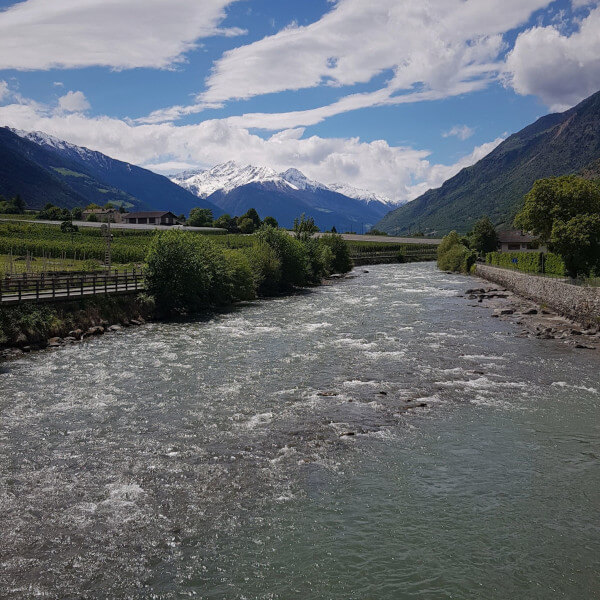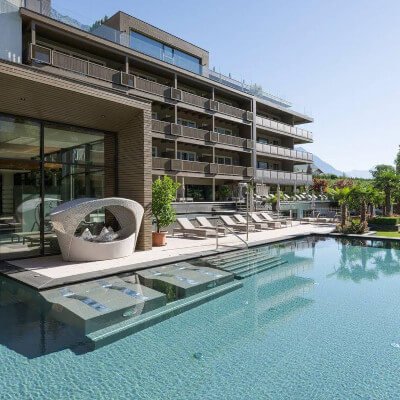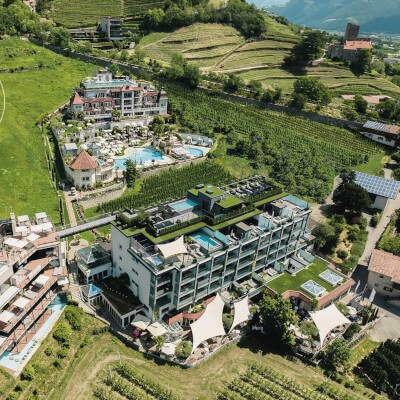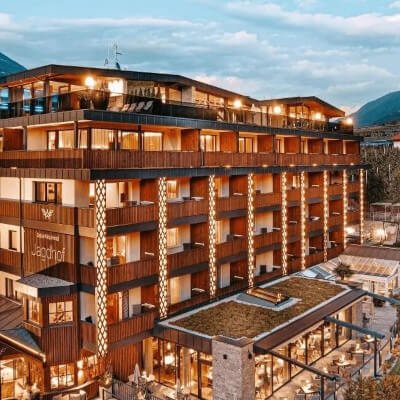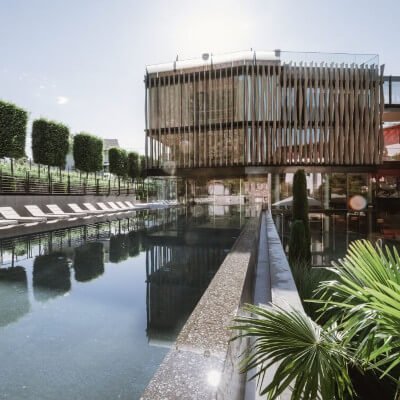Adige Bike Route
The cycle route along the historic Via Claudia Augusta
Description of the route
From Landeck in Austria, the Adige Cycle Path leads over the Reschen Pass (1,508 m.a.s.l.) to Merano and Bolzano and on to Verona in the Veneto region. The route of the long-distance cycle path follows the historic Roman road (Via Claudia Augusta), which has its starting point in Donauwörth (Germany) and was considered an important Roman trade route across the Alps.
The cycle path with a distance of 345 km starts in Landeck (816 m.a.s.l.) in Tyrol, leads through the Upper Inn Valley, to Martina (Switzerland) and Nauders (Austria) to the Reschen Pass (Italy).
The Etschradweg continues past the beautiful Reschensee lake, meandering through a varied landscape: meadows, forests, lakes and castles. The well-signposted (look for the Via Claudia Augusta sign) cycle path is mostly asphalted, partly gravelled or runs along quiet side roads. Fascinating villages and small towns with Mediterranean flair invite you to stop for a bite to eat.
If you want to avoid steep mountain stages, start at Reschen or in a municipality along the Vinschgau cycle path. Alternatively, you can use a bike shuttle or rent a bike.
FAQs about the Adige Cycle Path
- Where does the Etsch Cycle Path start?
-
The cycle route along the Etsch (Adige) River starts in Landeck (Austria) and leads to the Reschen Pass (Italy) through the Vinschgau Valley and the Etsch Valley to Verona. The Etsch River rises at the Reschen Pass in South Tyrol, which is why many people refer to the stage from the Reschen Pass to Merano (or Bolzano) as the Etschradweg (Etsch Cycle Path), although this actually means the Landeck-Verona cycle route. The start and direction are up to you. The start at the Reschen Pass requires the least effort.
- How long is the Etsch Cycle Path?
-
The Etsch Cycle Path has a length of over 345 kilometres from the start in Landeck to Verona. With the start at Reschen Pass and the finish in Verona, the length of the cycle path is approx. 280 kilometres. The cycle path section from the Reschen Pass to Merano is approx. 80 kilometres long. The Etsch Cycle Path largely follows the ancient Via Claudia Augusta road, which has a length of approx. 820 km (from Donauwörth to Verona).
- What is the course of the Etsch Cycle Path?
-
The cycle route follows the historic Via Claudia Augusta and was the easiest and most important route across the Alps for the Romans. The cycle route leads from Landeck in Tyrol through the Upper Inn Valley, to Martina (Switzerland) and Nauders (Austria) on the Reschen Pass (Italy). The cycle path runs well maintained to Merano, on to Bolzano and Trento and on to Verona.
- When is the best time to travel the Etsch Cycle Route?
-
The best time to travel is from May to October. The high summer months (July-August) can be very hot in some sections and should possibly be avoided. Partial stages (from Schlanders-Silandro) can also be ridden in March if the weather is good.
- Where is the Etsch Cycle Path the most beautiful?
-
It is difficult to say where the Adige Cycle Path is most beautiful, as this depends on personal preferences. However, here are some sections that many cyclists find particularly appealing:
- The section between the Reschen Pass and Bolzano (German: Bozen) offers spectacular views of the mountains (ex. Ortler) and valleys. There are also many historic towns and villages along the way, such as Glurns and Merano.
- The cycle path between Bolzano and Trento offers a varied landscape with vineyards, orchards and charming villages. The towns of Trento and Rovereto are also worth a visit.
- Near Verona, the cycle path leads through a picturesque landscape with hills, rivers and canals. Verona is famous for Renaissance architecture and works of art.
- How can I organise my return transfer at the end of this Cycle Route?
-
There are various ways to organise return transport at the end of your trip. Here are some options:
- Return transport by train: Most towns along the Adige Cycle Path are well connected to the Italian rail network, so you can take your bike on a regional train. There is a train station in Verona with connections to many cities throughout Italy or to Innsbruck and Munich. It is advisable to make a reservation in advance for bicycle transport.
- Return transport by bus: There are also bus companies that offer bicycle transport. Some buses have special bicycle trailers, while others allow bicycles to be transported on the bus itself.
- Return transport with a shuttle service: There are bike shuttles that specialise in transporting cyclists and their bikes back home. Some hotels along the cycle path also offer a shuttle service for guests. These companies can organise the return transport from Verona back to Landeck.
- Return transport by car: Have someone pick you up in Verona.
Whichever option you choose, it is important to plan your return transport in advance to avoid unnecessary stress at the end of your cycling trip.
Organise return transport
At the end of a cycling tour along the Etsch Cycle Path to Lake Garda or Verona, there are various options for your return journey. A popular choice is the return transport by train. Most towns along the cycling route are well connected to the Italian railway network, allowing you to take your bicycle on regional trains. Notably, the Verona train station offers connections to many cities across Italy, as well as to Innsbruck (Austria) and Munich (Germany). It is recommended to make a reservation for bicycle transport in advance.
Another option is return transport by bus. Some bus companies provide services for bicycle transport, either in special bike trailers or directly inside the bus. Alternatively, there are special bike shuttle services specialized in the return transport of cyclists and their bikes. Some hotels along the cycle path also offer shuttle services for their guests. These services can arrange return transport from Verona back to your starting place. Lastly, return transport by car is possible, where you can arrange to be picked up in Verona. Regardless of the option chosen, it is important to plan the return journey in advance to avoid unnecessary stress at the end of your cycling trip.
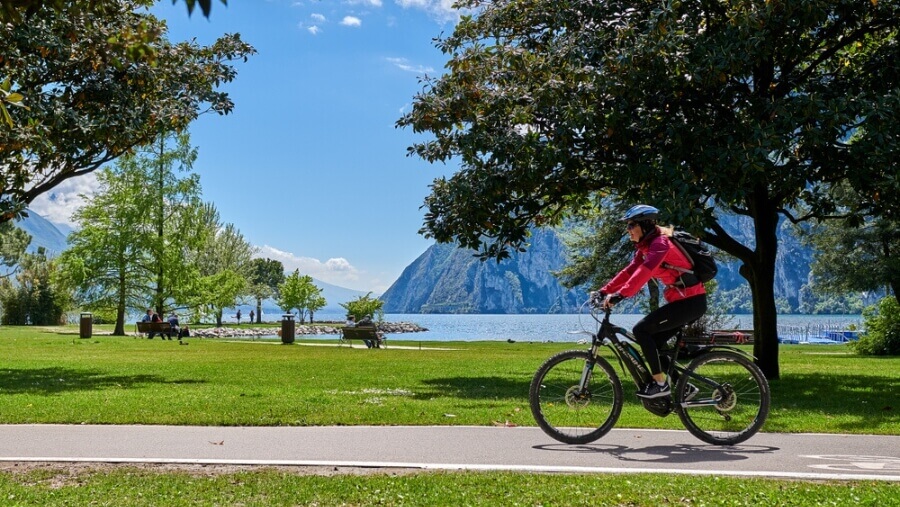
Ratings for the Adige Cycle Route
Adige Cycle Route: 3,79 / 5,00
61 ratings
Bike Map - Via Claudia Augusta
Download GPX-File (590,79 KB)Elevation Profile

Places along the Adige Cycle Route:
- Landeck
- Ried im Oberinntal
- Pfunds
- Martina
- Nauders
- Grenze Österreich - Italien am Reschenpass
- Graun im Vinschgau
- Mals
- Glurns
- Schluderns
- Laas
- Schlanders
- Latsch
- Kastelbell
- Naturns
- Partschins
- Algund
- Meran
- Bozen
- Trient
- Rovereto
- Mori
- Riva del Garda (optional)
- Ala
- Avio
- Verona
Adige river
The Etsch (Italian: Adige) rises above Reschen and, with a length of over 400 km, is the second longest river in Italy. It flows through the Vinschgau region with its low precipitation, enters the Merano basin after the Töll/Tell and flows through the South Tyrolean lowlands and Trentino towards the Mediterranean. The Adige passes Verona and flows into the Adriatic Sea at Porto Fossone. At the end of the 19th century and in the 20th century, the Adige was straightened and regulated in South Tyrol. Open Etsch details
Vacation in South Tyrol
Our 4 recommendations for your vacation in the region
